2023-12-11发布于海南




走进哈罗小学课堂,你会看到小朋友是这样的!
热爱阅读
对英语口语表达超有自信
英语写作生动有逻辑
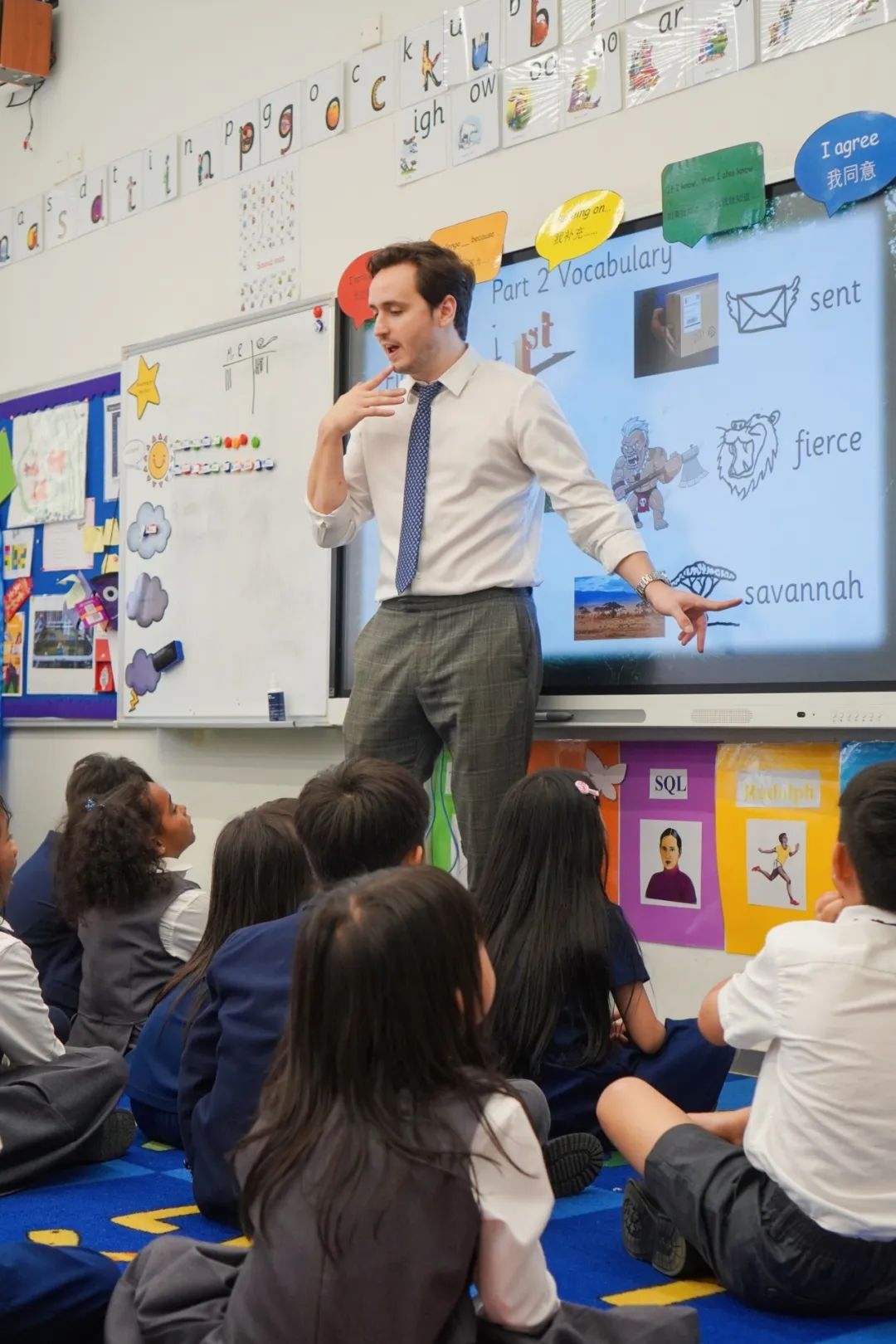

T4W Learning
/ HARROW

向左滑动阅读英文版本
Swipe Right to Read English Version
在哈罗海口,我们热衷于引导学生爱上阅读,在稳步提升阅读和拼读能力的基础上,本学年的教学重点更侧重于读写能力的提升。因此,继RWI自然拼读项目后,哈罗小学部今年创新性引入了Talk for Writing英语语言故事教学法(简称T4W)。
在开始了解T4W教学法前,我们一起来看看Y2一位同学在经过20天T4W学习的写作水平变化。

训练前的随机写作

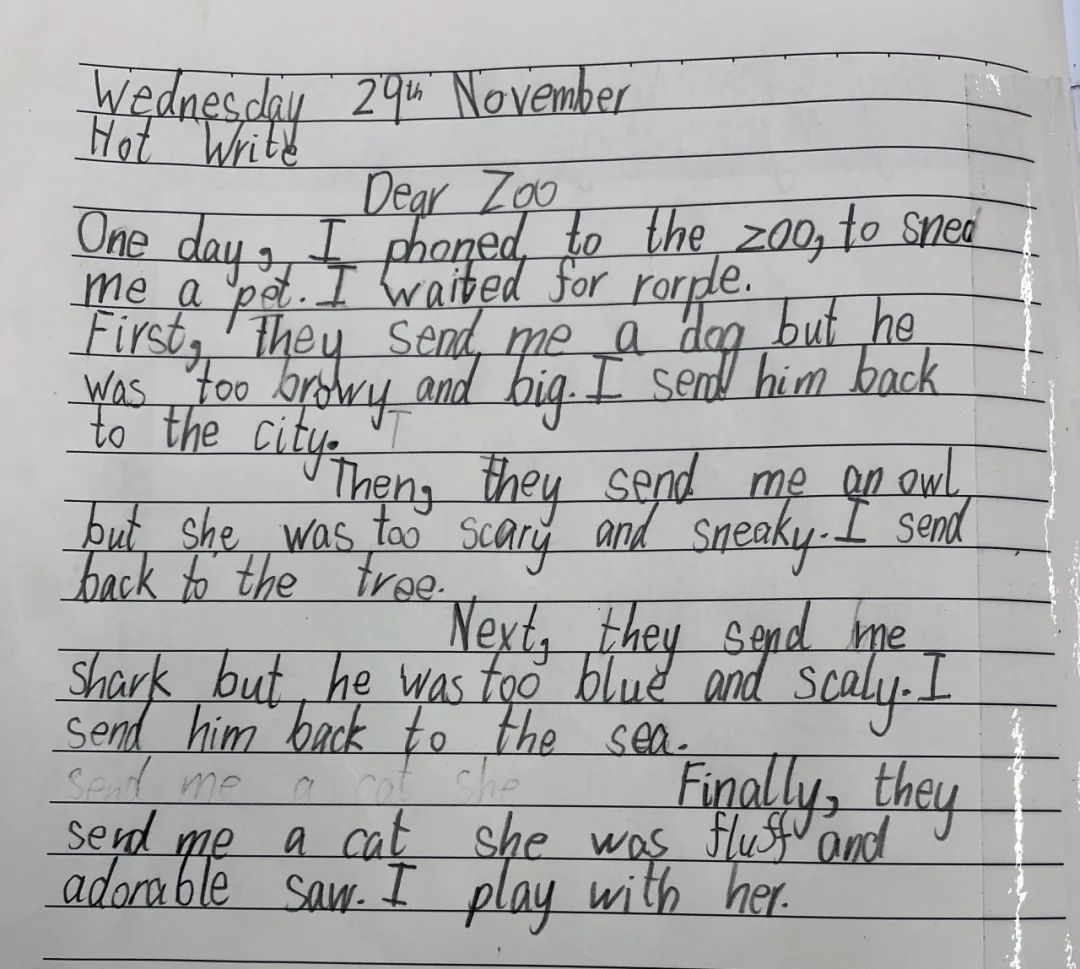
经过20天T4W训练后的写作

经过对比可以看到,孩子的写作内容变丰富了,更有逻辑了,词汇使用也更加生动多样了,故事情节也更加有趣起来!
在这20天时间内发生了什么?能让学生的英语写作水平突飞猛进?
——这得益于小学部的T4W教学法。
T4W英语语言故事教学法
这项教学法由英国著名的教育家Pie Corbett研发,在他40 多年的教学实践中,Corbett 先生发现,如果学生不会口语表达,那么他就很难做到书面表达,但口语表达的前提也一定要基于足够的耳濡目染。
Talk for Writing英语语言教学方法(简称“T4W 教学法”),被广泛应用于英国的小学教育中。是主要针对KS1阶段(英制1-3年级)的低龄学生,所设计的一套引导孩子进行阅读到完成独立写作的教学方法。
T4W教学法旨在提高学生们的口语表达、单词记忆、语法使用、阅读理解、书面表达等多种英语语言能力。在启发孩子们表达能力的同时,为孩子们打好坚实的语法和词汇基础,最终引导他们进行独立的写作创作。


向左滑动阅读英文版本
Swipe Right to Read English Version
为什么将T4W引进英语教学中呢?
哈罗海口小学英语学科协调员Mr Richards说到:
“ T4W 基于一个非常简单的道理,如果一个孩子不能开口说出句子,那么他就无法写出句子。所以我们需要更关注孩子的口头表达,在学生们开始输出写作作品之前,我们会投入大量的时间和精力在口头表达上。“
进入T4W的活跃课堂前,先来认识我们这节课的老师Mr Richards:

Darbi B Kirkman-Richards
小学英语学科协调员
英国杜伦大学教育学学士;
Darbi老师曾在英国萨里的一所小学担任主班老师,负责小学课程规划和教学,尤其擅长数学教学。同时他还建立了国际象棋和足球项目的课后俱乐部。教学之外,还曾兼任青少儿足球教练。
他是一位十分敬业、积极进取的教师,致力于学生的健康成长,确保所有学生茁壮成长、享受学习并取得优异进步。他也善于沟通,具有出色的协作能力,既能独立工作,也能作为团队一员开展工作。他始终精力充沛,充满热情,热衷于继续学习和发展自我。
向左滑动阅读英文版本
Swipe Right to Read English Version
在实际教学中,T4W遵循模仿-创新-创作的步骤,以Y2(一年级)Mr Richards的班级为例,我们来看看Mr Richards 如何将教学法运用到实践中,来帮助学生通过说的能力带动写作能力。
点击视频快速了解T4W课程实况




Walking into a classroom at the Pre-Prep of Harrow Haikou, you can see our children who
love reading,
have confidence in English oral expression,
and can write English stories in a logical way.


T4W Learning
/ HARROW

At Harrow Haikou, we are passionate about guiding our pupils to a love of English. On top of steadily improving their reading and spelling skills, the focus of this academic year has been more on literacy. Therefore, following the programme of RWI Phonics, the Pre-Prep of Harrow Haikou has innovatively introduced the Talk for Writing (T4W) teaching framework this year.
Before we start to understand what the T4W approach is, let's take a look at the change in the writing level of one of our Y2 pupils after 20 days of training with the T4W approach.

Cold Write


Hot write

It is clear that this pupil's writing is more informative and logical, the vocabulary used in the piece is more vivid and varied, and the storyline is more interesting than before!
What happened in those 20 days that could affect their writing so much?
This difference is brought about by the application of the Talk for Writing method.
The Talk for Writing (T4W)
Teaching Framework
Talk for Writing (T4W), developed by Mr. Pie Corbett, a British educator, is a method for raising standards of writing. In his more than 40 years of teaching practice, Mr. Corbett found that if a pupil could not express himself orally, it would be difficult for him to express himself in writing.
The Talk for Writing approach is widely used in primary education in the UK and it enables children to read and write independently for a variety of audiences and purposes within different subjects.
The T4W approach is designed to improve pupils' oral expression, vocabulary, grammar, reading comprehension, written expression, and many other English skills. It inspires children to express themselves while building a solid foundation in grammar and vocabulary, and ultimately guides them to develop the ability to write creatively and powerfully.

Why did we introduce T4W
into the teaching of English?
Mr. Richards, the English Subject Coordinator of Harrow Haikou Pre-Prep, said,
“ The T4W approach is based on the very simple truth that if a child can't speak in complete sentences, then he can't write them. That's why we need to pay more attention to a child's verbal expression. We invest a lot of time and effort in our pupils' verbal skills before they start writing“
Before we get into the classroom using T4W, we would like to introduce you to Mr. Richards, our teacher for this class:

Darbi B Kirkman-Richards
English Coordinator,
Pre-Prep
Bachelor of Education, Durham University, UK.
Mr. Richards worked as a Homeroom Teacher at an elementary school in Surrey, England, where he was responsible for elementary school curriculum planning, teaching, and assessment, with a particular focus on math. He also set up after-school clubs for chess and soccer programs. Outside of teaching, he has also coached youth soccer on a part-time basis. Highly dedicated and motivated teacher committed to pupil wellbeing and ensuring all children thrive, enjoy learning and make exceptional progress.
In practice, the T4W approach is based on the steps of imitation, innovation and invention. Taking Mr. Richards' Y2 class teaching as an example, let's see how he puts his teaching methodology into practice to help pupils develop their writing skills through the ability to speak.
Click the video to learn more about T4W practice
01

Imitation
写作模仿
Story Map——
将正在学习的故事转化成图片创作
首先,教师会选取一篇略高于学生语言水平的英语范文,这个范文会包含该阶段学生应该学习的词汇、语法知识、句法与段落结构、价值观念等学习内容。
Mr Richards为一年级的小朋友选择了Dear Zoo这篇短文,抛出一个有趣的问题吸引孩子们的注意力:
如果你能从动物园得到一只宠物,
你想得到什么?

课前词汇训练

在教授该文本前,他会挑出核心词汇,在与助教双语配合下花5分钟时间带孩子们快速记住词汇。然后和全班的孩子一起逐句阅读并带领他们制作一副 story map(故事地图),把整个故事的要点用简单的图形概括出来,就像为故事画了一个“地图”。
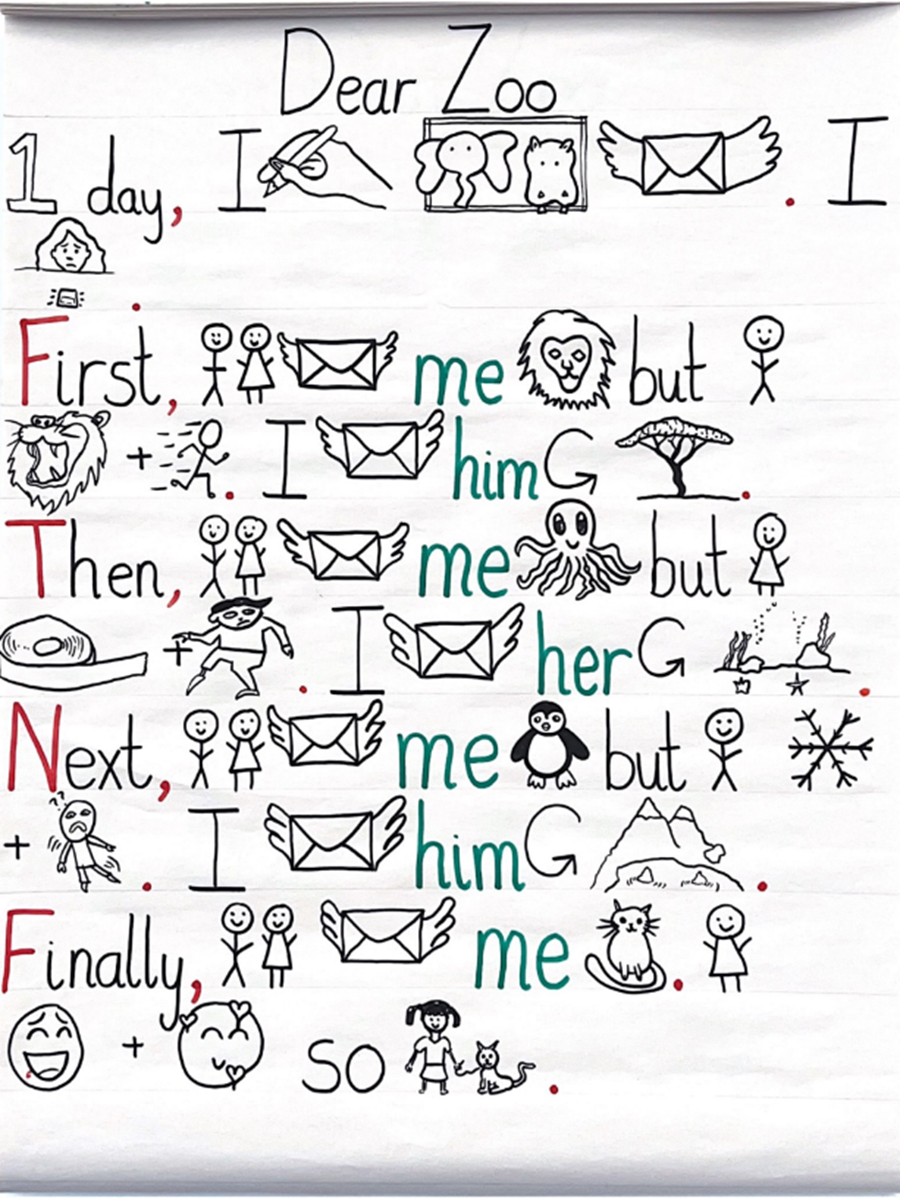
这是Mr Richards与小朋友们共同创作的故事地图,你能看图用英语表达动物园给Y2班的小朋友送了一只什么动物吗?
当一年级的学生们学习这个故事时,用自己的理解将读到的文字转换成图片创作,加深记忆。
在画完故事地图后,同学们已经基本掌握了故事情节,并学会阅读短文中的每一个词!对照故事地图,你猜出大概内容了吗?
查看下图文本揭晓答案!

戏剧演绎文本故事
写作从享受和分享故事开始。
有了story map,Mr Richards开始带领小朋友们“表演“这个故事并大声朗读,这是孩子们最喜欢的课堂环节。
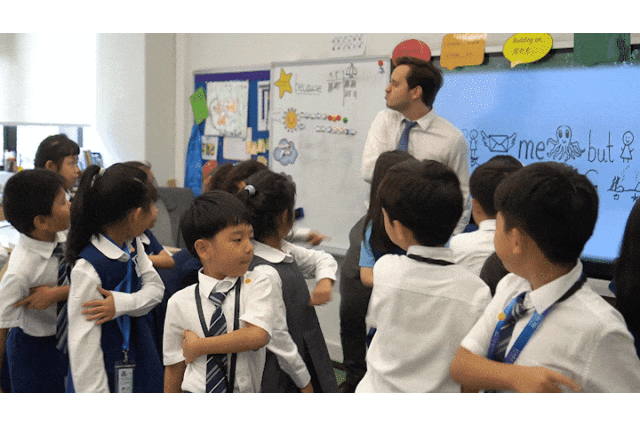
戏剧演绎在英语教学中尤为重要,通过情境对话和表演的方式,肢体、口、耳等感官的全方位调动,让孩子们一直浸泡在英语环境中,这种浸泡式的英语环境从思维和感观上会让孩子加深对英语语言的认知, 记忆变得更加印象深刻且高效。
孩子们一边看着故事地图,一边回想故事的词句并用肢体表达出来。在活跃的课堂氛围中,很快全班同学都记住了这个故事并且能够背诵出来。
02

Innovation
写作创新
通过模仿的方式,孩子们已经掌握了整个故事的内容,这时发挥孩子们的创造力来改写故事就变得容易很多。
改写故事
Story substitution
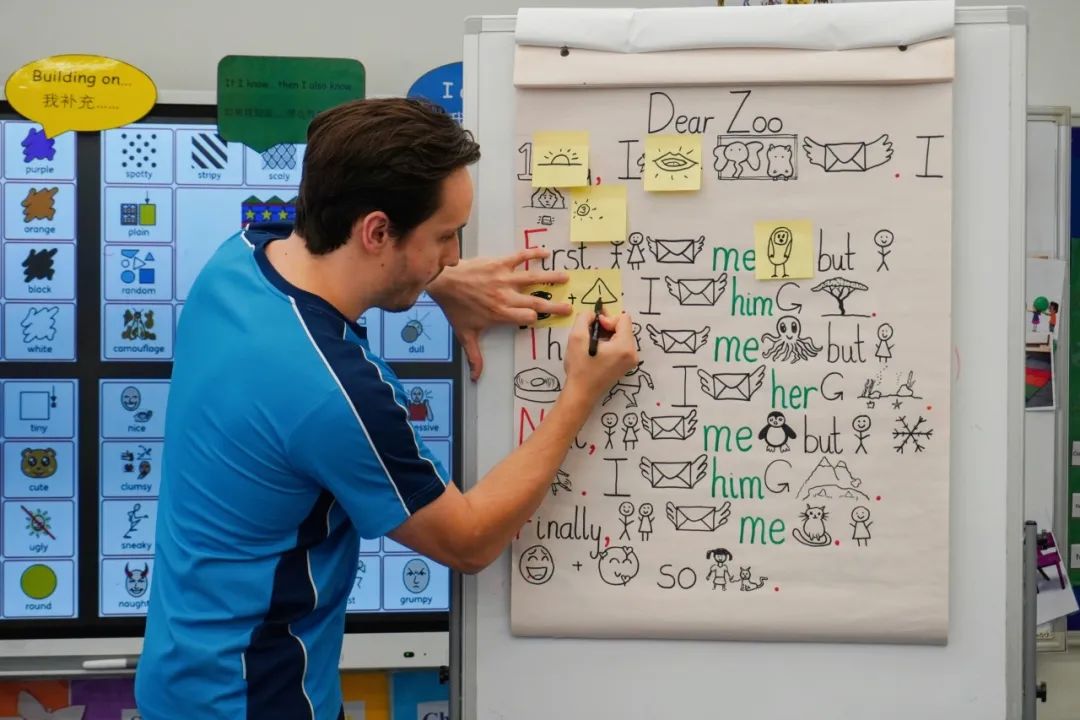
在保留基本句式的情况下,Mr Richards 用便利贴遮住原本的关键词汇。
让孩子来替换故事里的人称、食物、替换同义词,改变结尾,为故事添加新的内容等,通过更改范文来创造属于自己的故事版本。
写作技巧和逻辑
Teaching skill
为了让表达更加有序,学生们开始学习最基本、也是最为重要的表达技巧:
First——Then——Next——Finally
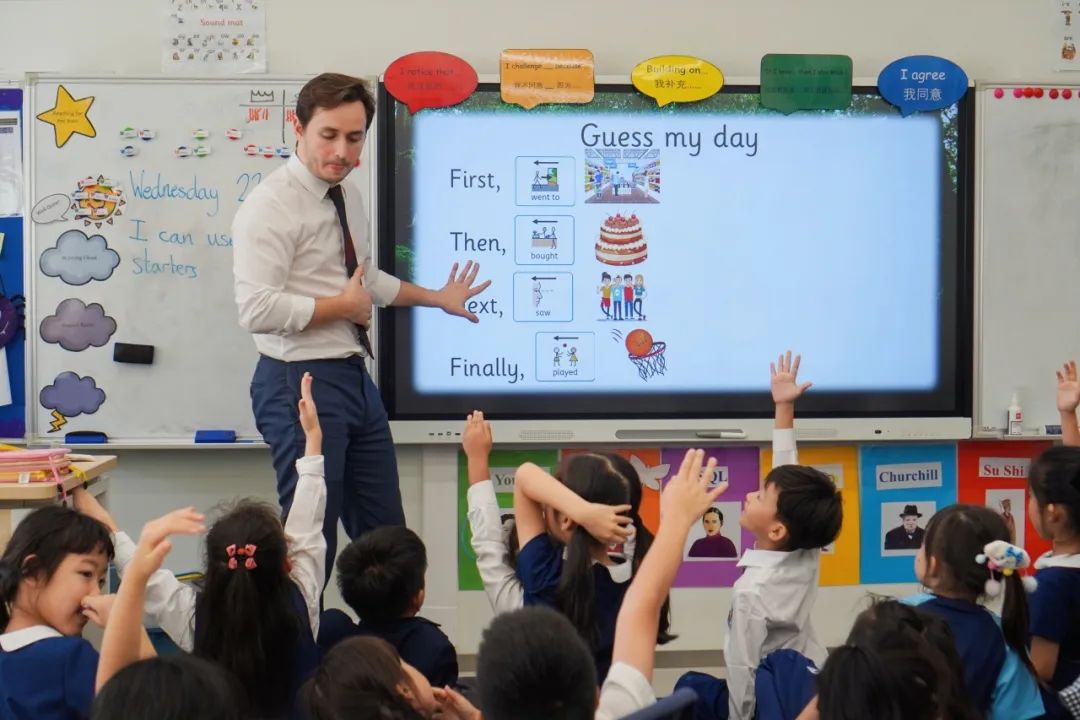
学生们用这个顺序来口头复述故事内容,此时助教念出中文,学生口译,重复训练帮助学生养成有逻辑的表达习惯,并反射性将其应用在写作中。
通过“模仿+改写”的方式,教师可以引导学生有意识地运用前三个过程中学习到的词汇及语法知识,最终达到词汇积累及语言表达能力的提升。
这样孩子就通过一个经典故事完成了听故事,读故事,表演故事,改编故事的环节。
03

Invention
独立写作
T4W最后阶段的学习是从模仿写作到独立写作。
在模仿写作时,Mr Richard 会手把手带着孩子们练习段落写作。当Mr Richard已经为学生输入了足够多的标准文本,并且学生已经能够游刃有余地进行复述与改写,老师就可以开始为学生提供新的课题和素材,引导孩子开展独立写作。
此时,学生在前几个步骤中学习并练习过的基础能力便有了用武之地。经过前几个步骤的锻炼,学生的表达意愿与创作热情也得到了积极的启发,学生可以较为顺利地展开承载其独立思想的写作练习。
在动笔前,要求每个孩子都需要构思好故事的人物、情节和故事发展的逻辑。再按照顺序逻辑开始独立写作。

哈
罗
Pre-Prep

从模仿到创新,从创新到独立应用,这种学习思路适应任何阶段学习者的需求。学生的反馈表明,T4W 教学法比起以往的英语语言教学更有趣,更具吸引力,能够激发学生的内在动力,继而有效提高学生的读写表达水平。T4W 甚至可以运用到其他科目,使学生能够进阶地阅读和书写表达不同类型的内容。
两周的T4W课程后,一年级小朋友们都能独立完成一篇完整的写作。
学生作品

经过学校的实践,会说就会写,也让孩子们对于英文写作变得越来越得心应手。一旦写作变得和说话一样稀松平常,那所谓的“写作难关”也就不存在了。
如何在家用强化T4W的学习?
许多家长提出疑问,在家如何帮助孩子使用这一方法来提升英语?
Mr Richard给出了他的回答:
许多可以在家里围绕 T4W 进行的练习应该是口头的,因为这样老师就可以在学校将其转到纠正写作上。
• 使用故事地图和肢体动作与学生一起练习阅读示范文本。- 教他们有感情地阅读文本,玩“文字网球”或进行阅读竞赛
• 要求他们将文本口头翻译成普通话
• 学习故事中新词汇的含义
• 练习改变故事中的部分或人物
• 角色扮演 - 假装您是故事中的角色之一 ——您在不同时刻有何感受?或有何新看法?
• 练习新词或关键词的拼写
• 为您正在学习的故事绘制故事地图
• 改写故事并为新故事绘制故事地图
• 尝试在日常生活中使用故事中适用于具体情况的短语

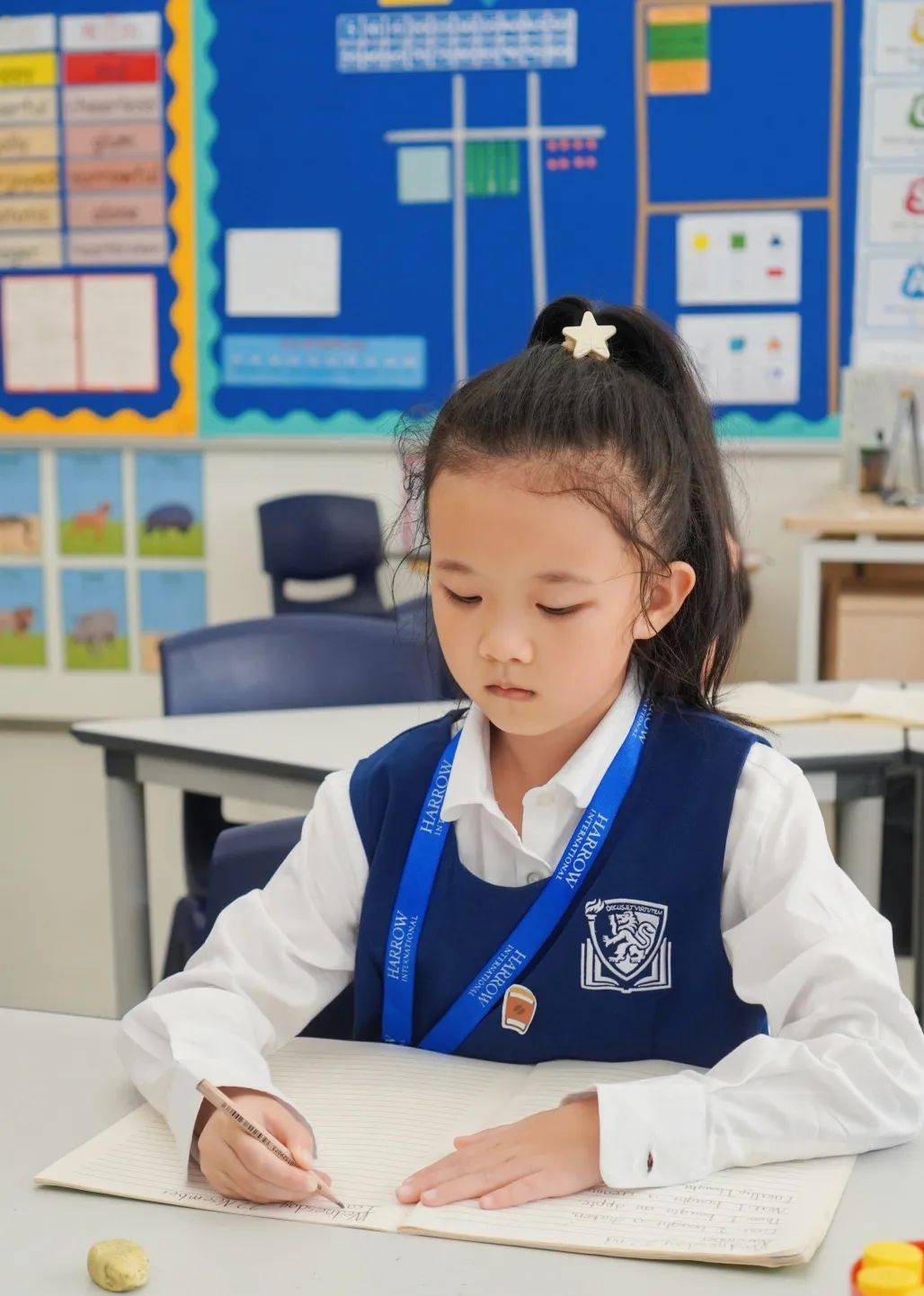
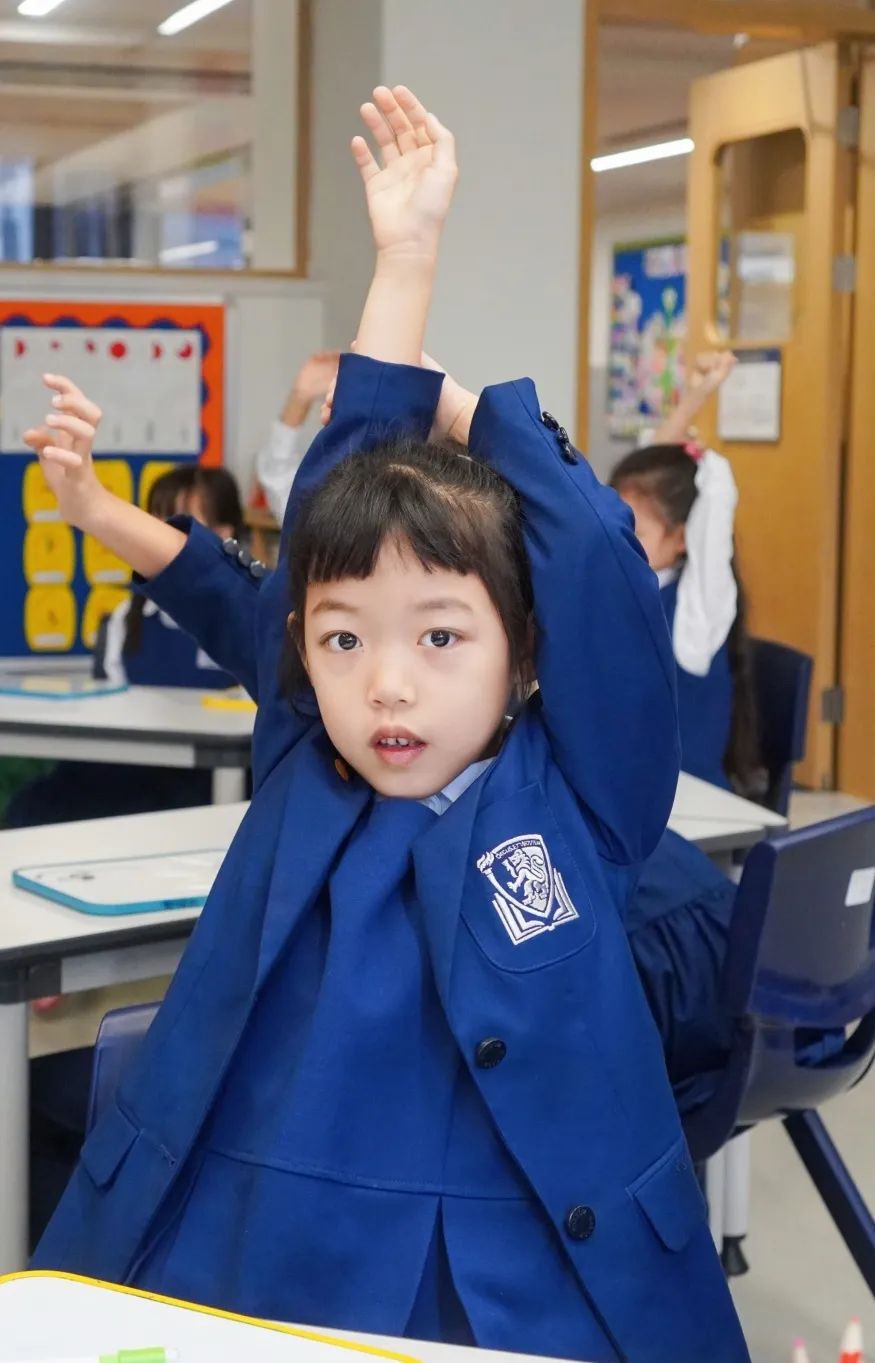

T4W Learning

教育的探索,永远都在路上。
哈罗一直致力于采用世界领先的教学法,帮助学生提高学习效率。
双语学习不仅是语言,更重要的是学会表达。不管是RWI教学法,还是T4W教学法,都是帮助学生从根源上、从思维上深入学习语言背后的思维,乃至用双语向别人表达自己的想法,说出自己的故事。
01

Imitation
写作模仿
Story Map——
Translating the story being learned into pictures
First, the teacher will select a model English text that is slightly above the language level of the pupils. This model text will contain the vocabulary, grammar knowledge, syntax and paragraph structure, and that pupils should be learning at that stage.
Mr. Richards has chosen the short text Dear Zoo for Y2 children, asking a fun question to attract the children's attention:
If you could get a pet from the zoo,
what would you want?

Vocabulary Training

Before teaching the text, he picks out the core vocabulary and spends 5 minutes supporting the children to memorise the vocabulary quickly, with a bilingual teaching assistant.
He then reads the text sentence by sentence with the class and leads them to create a story map, which summarizes the main points of the story in simple shapes, like a “map” for the story.

Here is the story map Mr. Richards created with the children. Can you look at the map and say in English what animal the zoo gave to Y2 children?
As the Y2 pupils study the story, they transform the words they read into pictures to deepen their memory.
After drawing the story map, the pupils have a basic grasp of the storyline and have learned to read every word in the short text! Can you guess the general content against the story map?
Check out the text below to see the answer!

Interpreting textual stories with drama
Writing begins with enjoying and sharing the story.
With the story map, Mr. Richards led the children to act out the story and read it aloud, which was the children's favourite part of the class.

Dramatic interpretation is particularly important in English language teaching, as it allows children to be immersed in an English environment through contextual dialogues and performance. This English environment will help pupils memorise efficiently and deepen their knowledge of English learning.
While looking at the story map, the children recall the words and phrases and express them physically. In the active classroom atmosphere, the whole class soon memorised the story and was able to recite it.
02

Innovation
写作创新
By imitating, the children have mastered the whole story, and it becomes much easier to use their creativity to rewrite the story.
Story substitution

While retaining the basic sentence structure, Mr. Richards uses sticky notes to cover up the original key vocabulary.
He then asks the children to create their own version of the story by changing the model text by substituting persons and foods, replacing synonyms, changing the ending, adding new elements to the story and so on.
Teaching skill
To make the expression more organised, pupils begin to learn the most basic, and most important techniques of expression:
First——Then——Next——Finally

Pupils use these words to retell the story orally, while the teaching assistant reads out the Chinese words and pupils interpret them. Repetition helps pupils develop the habit of expressing themselves logically and provides structure to use later in their writing.
Through "imitation + rewriting", teachers can guide pupils to consciously use the vocabulary and grammatical knowledge learned in the first three processes, and ultimately build up their vocabulary and improve their language skills.
In this way, the children complete the process of listening, reading, acting, and adapting a classic story.
03

Invention
独立写作
The final stage of T4W is from imitative writing to independent writing.
In imitative writing, Mr. Richards guides the children in practising paragraph writing. Once Mr. Richards has fed the pupils with enough standardised text and the pupils are comfortable with paraphrasing and rewriting, he can begin to provide the pupils with new topics and materials to guide them in their independent writing.
At this point, the basic skills that pupils have learned and practised in the previous steps can be applied. The pupils' willingness to express themselves and their enthusiasm for creativity has been stimulated after the previous steps, and the pupils can start the writing exercise that carries their independent thoughts more smoothly.
Before writing, each child is asked to think about the characters, the plot, and the logic of the story's development. Pupils will then begin to write independently.

哈
罗
Pre-Prep

The movement from imitation to innovation to independent application can be adapted to suit the needs of learners at any stage. Feedback from pupils indicates that the T4W approach is more interesting and engaging than other English language teaching methods, and that it stimulates pupils' motivation to improve their literacy and expressive skills, and that T4W can even be applied to other subjects to enable pupils to read and write different types of content.
After 2 weeks T4W learning, Year 2 students can complete an article independently.
Students' work

After practising in school, pupils become more comfortable with writing in English as long as they can talk.
Many parents want to know how they can help their children by using this method at home?
Mr. Richard’s answer is:
A lot of the practice that can be done around T4W at home should be verbal, as then the teachers can turn this in to correct writing at school.
✔ Practise reading the model text with them, with the story map and actions - teach them to read it with expression, play 'word tennis' or have a reading race.
✔ Ask them to verbally translate the text into Mandarin.
✔ Learn the meaning of new vocabulary in the story.
✔ Practise changing parts or characters in the story.
✔ Role play - pretend you are one of the characters in the story - how do you feel and what did you see at different points?
✔ Practise spellings of new or keywords.
✔ Draw a story map for the story you are learning.
✔ Change the story and draw a story map for your new story.
✔ Try to use phrases from the story in everyday life, when they apply to the situation.




T4W Learning

Different approaches to education are always explored.
Harrow has always been committed to adopting world-leading pedagogies to help pupils improve their learning efficiency.
Bilingual learning is not only about language but also about learning to express oneself. Whether it is the RWI programme or the T4W approach, it is all about helping pupils to learn the thinking behind the language from the root, and even to express themselves to others and tell their own stories in both languages.

哈罗海口校园开放日
预约开启中!
校园体验 | 校长面对面 | 招生官面谈
如您想了解
哈罗海口更多信息,
可以从以下校园开放日中择期参与!
请扫码下方二维码或添加招生官报名

Harrow Haikou School open day !
| Campus visit |
| Face to face talk with Haedmaster & Admission officer |
You are kindly advised to book your place
by scan the QR code below!

声明:本文内容为国际教育号作者发布,不代表国际教育网的观点和立场,本平台仅提供信息存储服务。
全国500所国际学校大全 / 3分钟匹配5-8所 / 1年名校升学备考托管服务






